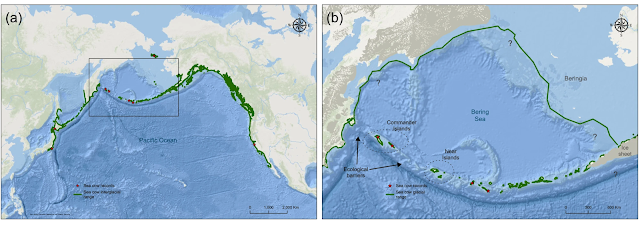Were Steller Sea Cows very rare as of 400,000 years ago?
(If so, human beings were likely not the main cause of their decline.)
Or were the Commander Islands just isolated from the rest of the range?
We suspect the latter.
Campos, A.A., C.D. Bullen, E.J. Gregr, I. McKechnie and K.M.A. Chan (2022). "Steller’s sea cow uncertain history illustrates importance of ecological context when interpreting demographic histories from genomes." Nature Communications 13(1): 3674. https://doi.org/10.1038/s41467-022-31381-6 (Open-access)
Figure. (a) Interglacial range. (b) Range during glacial maxima. The Commander Islands have always been physically isolated by deep channels - even during lowest sea levels - that likely constituted ecological barriers, or biogeographic breaks, for sea cows. Different lines of evidence (e.g., absence of echolocation or other navigational apparatus13; limited ability to submerge9; exclusive seaweed diet10) converge to a strictly coastal, ‘linear elongated’ distribution along kelp-dominated shorelines, a range that coincided with that of the sea otter, Enhydra lutris13. Sea cow range reconstructions were based on: (1) review of existing sea cow records (see Dataset); (2) bioindicators of sea cow habitat (i.e., kelp forests, sea otter historical ranges14); (3) southern extent of winter drift ice and year-round kelp habitat;15,16 and (4) the estimated shoreline of Beringia and Bering Sea islands during the Last Glacial Maximum12. ‘Sea cow records’ (red stars) refer to undisputed records only. Question marks refer to uncertainties related to sea ice extent along the shoreline of Beringia during glacial times. Map background image source and license: Maps were created using ArcGIS Online basemap ‘World Ocean Base’ (Esri, GEBCO, DeLorne, NaturalVue) and using ArcGIS® software by Esri. ArcGIS® and ArcMap™ are the intellectual property of Esri and are used herein under license. Copyright © Esri. All rights reserved. For more information about Esri® software, please visit www.esri.com.
Our paper responds to an article by Sharko et al. who argued (based on DNA from one sea cow from the Commander Islands) that sea cows’ population had greatly contracted some 400,000 years ago. The implication was that humans were not the primary cause of sea cows’ decline (because humans arrived much later).
Our paper argues that the Commander Islands were likely isolated from the rest of the sea cow range, using a range of different forms of evidence. Accordingly, the 400,000 year figure likely represents the time of isolation of the Commander Islands population rather than a range-wide population decline.
More generally we argue that genetic techniques for inferring ecological histories need to better account for the ecology of the relevant species and the geography of the range.

CHANS Lab Views by Kai Chan's lab is licensed under a Creative Commons Attribution-ShareAlike 4.0 International License.
Based on a work at https://chanslabviews.blogspot.com.

